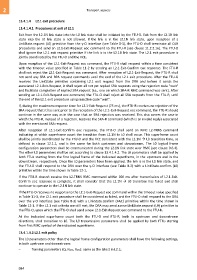Page 994 - 5G Basics - Core Network Aspects
P. 994
2 Transport aspects
13.4.1.4 L2.1 exit procedure
13.4.1.4.1 Procedures at exit of L2.1
Exit from the L2.1N link state into the L0 link state shall be initiated by the FTU-O. Exit from the L2.1B link
state into the L0 link state is not allowed. If the link is in the L2.1N link state, upon reception of a
LinkState.request (L0) primitive from the γ-O interface (see Table 8-3), the FTU-O shall terminate all OLR
procedures and send an L2.1-Exit-Request eoc command to the FTU-R (see clause 11.2.2.16). The FTU-O
shall ignore the L2.1 exit request primitive if the link is in the L2.1B link state. The L2.1 exit procedure is
jointly coordinated by the FTU-O and the VCE.
Upon reception of the L2.1-Exit-Request eoc command, the FTU-R shall respond within a time consistent
with the timeout value specified in Table 11-2 by sending an L2.1-Exit-Confirm eoc response. The FTU-R
shall not reject the L2.1-Exit-Request eoc command. After reception of L2.1-Exit-Request, the FTU-R shall
not send any SRA and RPA request commands until the end of the L2.1 exit procedure. After the FTU-O
receives the LinkState primitive containing L2.1 exit request from the DRA and before it sends the
associated L2.1-Exit-Request, it shall reject all not yet replied SRA requests using the rejection code "wait"
and facilitate completion of replied SRA request (i.e., one on which SRA-R RMC command was sent). After
sending an L2.1-Exit-Request eoc command, the FTU-O shall reject all SRA requests from the FTU-R, until
the end of the L2.1 exit procedure using rejection code "wait".
If, during the maximum response time for L2.1-Exit-Request (75 ms), the FTU-R receives no rejection of the
SRA request that it has sent prior to the reception of the L2.1-Exit-Request eoc command, the FTU-R should
continue in the same way as in the case that an SRA rejection was received. This also covers the case in
which the FTU-R, instead of a rejection, receives the SRA-R command (which is an invalid reply) associated
with the mentioned SRA request.
After reception of L2.1-Exit-Confirm eoc response, the FTU-O shall send an RMC L2-TRNS command
indicating at which superframe count the transition from L2.1N to L0 shall occur. This superframe count
shall be jointly coordinated by the FTU-O and the VCE consistent with the L2.1N L0 transition time, as
defined in clause 12.1.1, and is the same for both upstream and downstream. The L0 logical frame
configuration parameters shall be communicated during the L2.1N link state over RMC (see clause 9.6.4).
The other L0 parameters shall be set according to clause 13.4.1.4.2. The L0 parameters shall be applied by
both FTUs starting from the first logical frame of the indicated superframe, in the upstream and in the
downstream, respectively. Once the L0 parameters have been applied, the link is in the L0 link state, and
the FTU-O shall respond to the DRA over the γ-O interface (see Table 8-3) with a LinkState.confirm (L0)
primitive within the time shown in Table 12-1.
If the FTU-R doesn't receive the L2-TRNS RMC command within 100 ms after transmission of L2.1-Exit-
Confirm eoc response is complete, it shall consider that the L2.1N L0 transition has failed and shall
continue to operate in the L2.1N link state.
If the FTU-O receives no response to the L2.1-Exit-Request eoc command within the timeout value specified
in Table 11-3, the L2.1 exit procedure shall be considered as failed, and the FTU-O shall respond to the DRA
over the γ-O interface (see Table 8-3) with a LinkState.confirm (FAIL) primitive within the time shown in
Table 12-1. If the L2.1 exit criteria are still met, the DRA may send a new LinkState.request (L0) primitive to
the FTU-O, upon which the FTU-O shall send a new L2.1-Exit-Request eoc command to the FTU-R.
At the indicated superframe count both the FTU-O and FTU-R, both in upstream and downstream
directions, shall transition to L0. The L0 transmission parameters shall be applied by both FTUs starting
from first RMC symbol of the indicated superframe.
13.4.1.4.2 L2.1 exit policy
The L0 parameters other than the logical frame configuration parameters shall have the following settings,
in both upstream and downstream:
– framing parameters (Q, NFEC, RFEC): same as the latest in L2.1;
984

